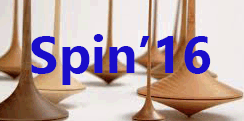Speaker
Description
Few-nucleon scattering at intermediate energies (E/A ∼ 200 MeV) is one attractive approach to investigate the dynamical aspects of 3NFs, such as momentum and/or spin dependences. Direct comparison between the data and the rigorous numerical calculations based on bare nuclear potentials provides information of 3NFs. So far large 3NF effects are theoretically predicted and experimentally confirmed in the cross section minimum for dp scattering at ∼ 100 MeV/nucleon. With the aim of clarifying roles of the 3NFs in nuclei the experimental programs with polarized deuterons beams at intermediate energies are in progress at RIKEN RI Beam Factory (RIBF) [1]. We have measured all deuteron analyzing powers (iT11, T20, T21, and T22) for deuteron–proton (dp) elastic scattering at 70 300 MeV/nucleon, typically in step of 50 MeV/nucleon. The vector and tensor polarized deuteron beams were accelerated by three cyclotrons, AVF, RRC and SRC. The measurement of deuteron analyzing powers for elastic dp scattering was carried out using the polarimeter BigDpol installed at the extraction beam line of the SRC. The deuteron beams bombarded a polyethylene (CH2) target in the scattering chamber. Scattered deuterons and recoil protons were detected by plastic scintillators in kinematical coincidence conditions.
The obtained high precision data are compared with the results of three-nucleon Faddeev calculations based on the nucleon nucleon (NN) potentials; i.e. CD Bonn, Argonne V18, Nijmegen I, and II, alone or combined with the Tucson-Melbourne’99 and the Urbana IX 3NFs. Large discrepancies between the pure NN theory and the data, which are not resolved even by adding the current 3NFs, are found at the c.m. backward angles for almost all the deuteron analyzing powers with increasing an incident energy. In the conference the comparison between the data and the calculations based on the χ EFT potentials [2] will also be presented.
[1] K. Sekiguchi et al., Phys. Rev. C 83, 061001 (2011); K. Sekiguchi et al., ibid 89, 064007 (2014).
[2] S. Binder et al., Phys. Rev. C 93, 044002 (2016).
